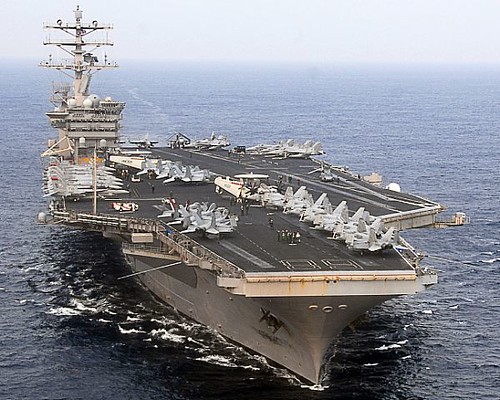
CVN68 - Nimitz Class Aircraft Carrier
Aircraft carriers provide a wide range of possible response for the National Command Authority. They provide a credible, sustainable, independent forward presence and conventional deterrence in peacetime, operate as the cornerstone of joint/allied maritime expeditionary forces in times of crisis, and operate and support aircraft attacks on enemies, protect friendly forces and engage in sustained independent operations in war.

History
The aircraft carrier continues to be the centerpiece of the forces necessary for forward presence. Whenever there has been a crisis, the first question has been: "Where are the carriers?" Carriers support and operate aircraft that engage in attacks on airborne, afloat, and ashore targets that threaten free use of the sea; and engage in sustained operations in support of other forces.

Aircraft carriers are deployed worldwide in support of U.S. interests and commitments. They can respond to global crises in ways ranging from peacetime presence to full-scale war. Together with their on-board air wings, the carriers have vital roles across the full spectrum of conflict. The Nimitz-class carriers, eight operational and two under construction, are the largest warships in the world. USS Nimitz (CVN 68) was the first to undergo its initial refueling during a 33-month Refueling Complex Overhaul at Newport News Shipbuilding in Newport News, Va., in 1998. The next generation of carrier, CVN 21, the hull number will be CVN 78, is programmed to start construction in 2007 and is slated to be placed in commission in 2014 to replace USS Enterprise (CVN 65 which will be over its 50-year mark. CVN 79 is programmed to begin construction in 2012 and to be placed in commission in 2018, replacing USS John F. Kennedy (CV 67) in her 50th year.
Description
Centerpiece and Flagship of the Navy's "Forward....from the sea..." power projection mission. Hosting 85 aircraft and carrying enough supplies to sustain her Air Wing and escorts for 90 days, the modern U.S. Navy aircraft carrier, in effect, represents a mobile piece of American real estate, capable of projecting the power and influence of the United States any where in the world. With the end of the Cold War the navy carrier mission has shifted from maintaining Sea Lanes of Communication and confronting the Soviet Navy to addressing regional threats to U.S. interests. While still fully capable of dominating the open seas, the Navy, through the Carrier Battle Groups, now focuses on supporting near shore "littoral zone" and inshore U.S. ground operations. While the Ticonderoga class Guided Missile Cruisers and Arleigh Burke class Guided Missile Destroyers possess an awsome amount of firepower, they lack the flexability of the carrier air wing. By swaping out and adjusting the number of aircraft aboard, the aircraft carrier can tailor its air wing to meet mission needs. The Nimitz-class carriers, eight operational and one under construction, are the largest, most powerful, warships in the world. The USS Nimitz (CVN 68) underwent its first refueling during a 33-month Refueling Complex Overhaul at Newport News Shipbuilding in Newport News, Va., in 1998.
No comments:
Post a Comment